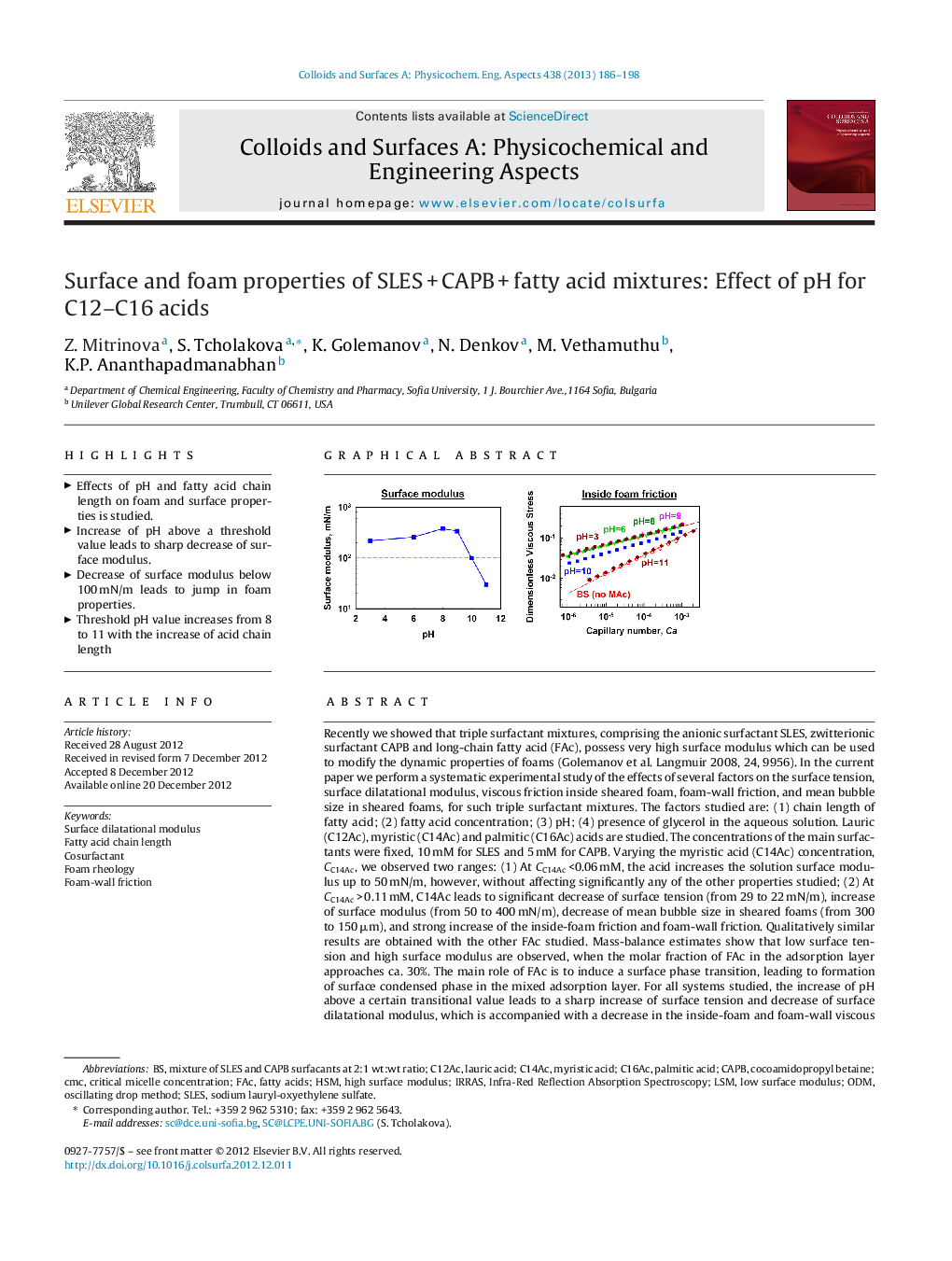| کد مقاله | کد نشریه | سال انتشار | مقاله انگلیسی | نسخه تمام متن |
|---|---|---|---|---|
| 593294 | 1453935 | 2013 | 13 صفحه PDF | دانلود رایگان |

Recently we showed that triple surfactant mixtures, comprising the anionic surfactant SLES, zwitterionic surfactant CAPB and long-chain fatty acid (FAc), possess very high surface modulus which can be used to modify the dynamic properties of foams (Golemanov et al. Langmuir 2008, 24, 9956). In the current paper we perform a systematic experimental study of the effects of several factors on the surface tension, surface dilatational modulus, viscous friction inside sheared foam, foam-wall friction, and mean bubble size in sheared foams, for such triple surfactant mixtures. The factors studied are: (1) chain length of fatty acid; (2) fatty acid concentration; (3) pH; (4) presence of glycerol in the aqueous solution. Lauric (C12Ac), myristic (C14Ac) and palmitic (C16Ac) acids are studied. The concentrations of the main surfactants were fixed, 10 mM for SLES and 5 mM for CAPB. Varying the myristic acid (C14Ac) concentration, CC14Ac, we observed two ranges: (1) At CC14Ac <0.06 mM, the acid increases the solution surface modulus up to 50 mN/m, however, without affecting significantly any of the other properties studied; (2) At CC14Ac > 0.11 mM, C14Ac leads to significant decrease of surface tension (from 29 to 22 mN/m), increase of surface modulus (from 50 to 400 mN/m), decrease of mean bubble size in sheared foams (from 300 to 150 μm), and strong increase of the inside-foam friction and foam-wall friction. Qualitatively similar results are obtained with the other FAc studied. Mass-balance estimates show that low surface tension and high surface modulus are observed, when the molar fraction of FAc in the adsorption layer approaches ca. 30%. The main role of FAc is to induce a surface phase transition, leading to formation of surface condensed phase in the mixed adsorption layer. For all systems studied, the increase of pH above a certain transitional value leads to a sharp increase of surface tension and decrease of surface dilatational modulus, which is accompanied with a decrease in the inside-foam and foam-wall viscous friction. The transitional pH value varies between 8 and 11, and increases with the fatty acid chain-length. The increase of pH causes ionization of the FAc molecules – the latter start to behave as usual anionic surfactant without forming surface condensed phase. The main effect of glycerol is to decrease the transitional pH (by 1 to 1.5 units for 40 wt% glycerol), without affecting significantly the system properties away from the transitional pH. These results clarify the compositional domain, in which the fatty acids can be used for control of surface and foam properties in such surfactant mixtures.
Figure optionsDownload as PowerPoint slideHighlights
► Effects of pH and fatty acid chain length on foam and surface properties is studied.
► Increase of pH above a threshold value leads to sharp decrease of surface modulus.
► Decrease of surface modulus below 100 mN/m leads to jump in foam properties.
► Threshold pH value increases from 8 to 11 with the increase of acid chain length
Journal: Colloids and Surfaces A: Physicochemical and Engineering Aspects - Volume 438, 5 December 2013, Pages 186–198